Finding the right hiking gear can ease your nerves and enhance your experience outdoors. Start with comfortable footwear for support and moisture-wicking socks to keep your feet dry. Opt for breathable clothing that regulates temperature and allows for movement. Don't forget hydration packs for hands-free drinking. Pack snacks like trail mix or energy bars for quick energy boosts. Consider carrying a nature journal to reflect on your surroundings. Essential oils, like lavender, can create a calming atmosphere, too. There's much more to discover about gear that supports your serenity in the wild.
Comfortable Footwear
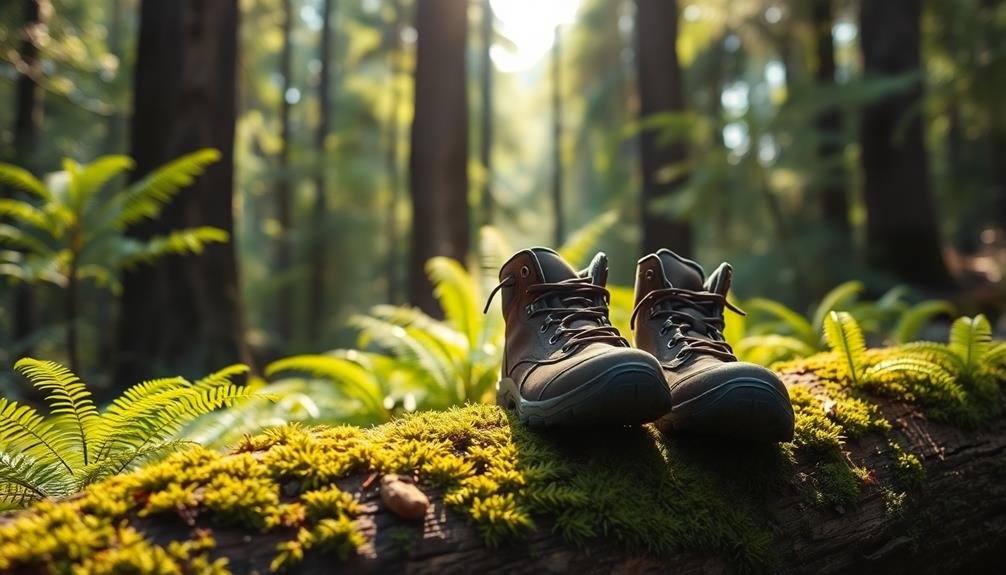
When you're hitting the trails, comfortable footwear is essential for an enjoyable experience. The right shoes can make all the difference in how you feel during your hike. You'll want to choose footwear that provides good support and cushioning, allowing you to traverse rocky paths and uneven terrain with ease.
A well-fitted pair of hiking boots or shoes can minimize blisters and sore spots, so you can focus on the beauty around you instead of your aching feet.
Consider the type of hike you're planning. If you're tackling rugged trails, opt for boots with sturdy soles and ankle support. For lighter walks on well-maintained paths, trail runners might suffice.
Remember to break in any new footwear before your hike; this'll help prevent discomfort and guarantee you're ready for the journey ahead.
When selecting socks, choose moisture-wicking materials that keep your feet dry, further enhancing your comfort. Layering your socks can also provide extra cushioning if needed.
Ultimately, investing time and thought into your footwear choice will help calm your nerves and let you fully immerse yourself in nature. Enjoy your adventure, knowing your feet are well taken care of!
Breathable Clothing
Breathable clothing is essential for staying comfortable on the trail. When you're out hiking, you need gear that helps regulate your body temperature and wicks away moisture. This way, you can focus on enjoying nature instead of feeling restricted by your outfit.
Here are three must-have breathable clothing items for your next hike:
- Moisture-Wicking Base Layers: These fabrics pull sweat away from your skin, helping you stay dry and comfortable. Look for lightweight materials that allow for easy movement.
- Ventilated Hiking Shirts: Opt for shirts with mesh panels or vents to promote airflow. Long sleeves protect you from sun exposure while keeping you cool.
- Quick-Drying Pants or Shorts: Choose pants or shorts made from synthetic materials that dry quickly when wet. This feature is especially helpful if you encounter unexpected rain or stream crossings.
Hydration Packs

Staying properly hydrated is essential for any hiking adventure, and hydration packs offer a convenient solution. Unlike traditional water bottles, hydration packs allow you to sip water hands-free using a straw, so you can focus on the trail ahead without stopping frequently. This feature can help calm your nerves, as staying hydrated keeps your energy levels steady and your mind clear.
Here's a quick comparison of hydration packs versus traditional bottles:
| Feature | Hydration Packs |
|---|---|
| Hands-free drinking | Yes |
| Weight | Lightweight |
| Capacity | 1-3 liters |
| Ease of refill | Simple |
With hydration packs, you can seamlessly carry water without the bulk and hassle of bottles. This streamlined design helps you stay focused on your hike, making it easier to enjoy the scenery and clear your mind. Plus, many packs have pockets for essentials, so you can keep everything organized while you explore. Investing in a hydration pack can enhance your outdoor experience, turning potential stress into a more enjoyable, calming adventure.
Lightweight Backpacks
When you're out on the trail, a lightweight backpack can make all the difference in how you feel.
It's crucial to reflect on weight distribution and features that enhance comfort, so you can focus on enjoying your hike.
Let's explore how the right pack can lighten your load and ease your nerves.
Importance of Weight Distribution
Choosing the right backpack can make all the difference in your hiking experience, especially when it comes to weight distribution. Proper weight distribution reduces strain on your body, allowing for a more enjoyable trek.
If your backpack's weight isn't balanced, it can lead to discomfort, fatigue, and even injury. Here are three key factors to take into account for effective weight distribution:
- Pack Placement: Keep heavier items close to your back and centered. This minimizes the leverage on your body and helps maintain your balance.
- Load Adjustability: Look for backpacks with adjustable straps and compartments. These features let you customize the placement of your gear, optimizing weight distribution as you hike.
- Hip Belt Usage: Don't underestimate the power of a good hip belt. It transfers some of the pack's weight to your hips, relieving pressure from your shoulders, which is essential for longer hikes.
Features for Comfort
A well-fitted lightweight backpack can greatly enhance your comfort on the trail, especially after ensuring proper weight distribution. When you choose a backpack that's designed for your body type, it feels less cumbersome and allows for easier movement.
Look for adjustable straps that help you find that perfect fit, preventing chafing and discomfort during your hike.
Ventilation is another key feature. Many lightweight backpacks come with breathable materials or mesh panels that keep your back cool and dry, reducing sweat and irritation.
Don't forget about padding—both on the shoulder straps and the back panel. Quality padding can make a significant difference, providing cushioning and support during long treks.
Consider pockets and compartments, too. A well-organized backpack allows you to access your gear easily, which can reduce frustration and keep your mind at ease.
Nature Journals

Capture your observations in a nature journal, and you'll enhance your hiking experience like never before. By jotting down your thoughts and sketches, you create a personal connection with the environment that helps calm your nerves.
Here are three reasons why you should start a nature journal:
- Mindfulness: Writing about your surroundings forces you to slow down and appreciate the little things, like the rustle of leaves or the call of a distant bird. This mindfulness can considerably reduce anxiety.
- Reflection: After a hike, reviewing your entries allows you to reflect on your journey. You can track your emotional state, notice patterns in your mood, and recognize how nature impacts your well-being.
- Creativity: A nature journal is more than just a log; it's a canvas for your creativity. Sketching, painting, or even composing poetry can be therapeutic, providing an outlet for your feelings and thoughts.
Portable Seating
When you're out on the trail, having portable seating can make all the difference in your hiking experience. Taking a break on a comfortable seat lets you recharge and enjoy the scenery, helping calm your nerves. Here are some popular options to contemplate:
| Type of Seating | Weight | Key Feature |
|---|---|---|
| Lightweight Chair | 2-3 lbs | Easy to set up, durable |
| Portable Stool | 1-2 lbs | Compact, great for quick rests |
| Inflatable Seat | 0.5-1 lb | Packs down small, comfy |
| Folding Bench | 4-5 lbs | Seats multiple people, sturdy |
| Hammock | 1-2 lbs | Relaxing, requires trees |
Each type has its benefits, so think about what fits your hiking style best. A lightweight chair offers comfort and support, while a stool is perfect if you want something ultra-compact. An inflatable seat is excellent for minimalists, and a folding bench can be a social hub for friends. Finally, a hammock turns any spot into a cozy retreat. Choose wisely, and you'll create a more enjoyable and calming hiking experience!
First Aid Kits
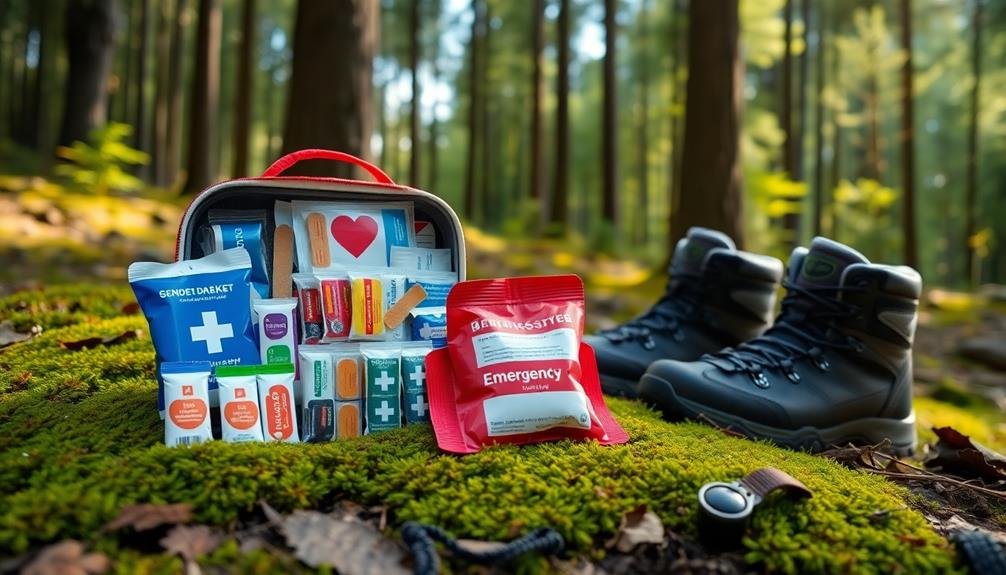
Packing a well-equipped first aid kit is vital for any hiking adventure, as it can help you tackle unexpected injuries and illnesses on the trail.
Having the right supplies gives you peace of mind and allows you to focus on enjoying nature rather than worrying about what might go wrong.
Here are three must-have items for your first aid kit:
- Adhesive Bandages: These are essential for covering small cuts and scrapes. They help to keep dirt out and promote healing.
- Antiseptic Wipes: These are important for cleaning wounds. They reduce the risk of infection and guarantee that you're addressing injuries properly.
- Pain Relievers: Bringing along over-the-counter pain relievers, like ibuprofen or acetaminophen, can help alleviate headaches or muscle soreness that may arise during your hike.
Noise-Canceling Headphones
Noise-canceling headphones can transform your hiking experience by creating a serene escape from the hustle and bustle of the outside world.
When you strap on your pack and hit the trail, these headphones let you immerse yourself in nature without distractions. You can tune out everything from the sounds of nearby traffic to the chatter of fellow hikers, allowing you to focus on the rhythmic sound of your footsteps and the rustling leaves.
With your favorite calming playlist or nature sounds, you can cultivate a meditative atmosphere that helps reduce anxiety. The moment you press play, you'll find that the stresses of daily life fade into the background, leaving you with a sense of peace.
Whether you're hiking a steep incline or strolling along a gentle path, these headphones can keep your mind centered and relaxed.
Just remember to stay aware of your surroundings. You don't want to miss important sounds, like wildlife or approaching fellow hikers, which could enhance your outdoor experience.
Hiking Poles
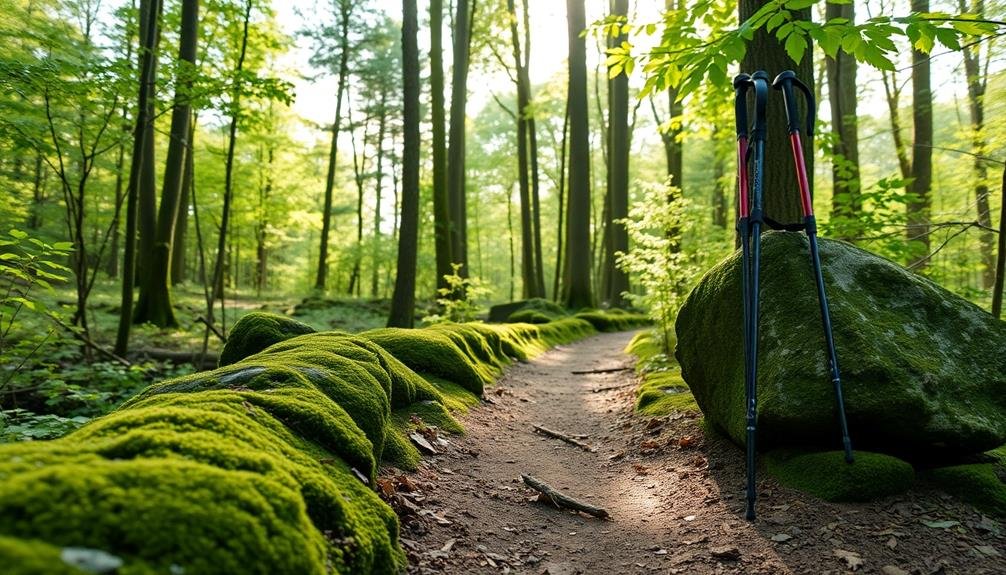
When you tackle uneven terrain, hiking poles can be your best friend.
They provide stability and help enhance your balance and control on tricky paths.
With the right poles, you'll feel more confident and secure during your hike.
Stability on Uneven Terrain
Traversing uneven terrain can be a challenge, but hiking poles can make a world of difference. They offer you the stability and support you need to navigate rocky paths, steep inclines, and slippery descents.
With the right hiking poles, you'll find that your confidence grows, allowing you to focus on the beauty around you rather than worrying about your footing.
Here are three benefits that demonstrate how hiking poles enhance stability:
- Weight Distribution: By shifting some of your weight onto the poles, you reduce pressure on your legs and joints, making it easier to maintain balance.
- Increased Traction: When you plant your poles firmly into the ground, they provide additional points of contact, helping you grip uneven surfaces better.
- Adjustable Length: Many hiking poles come with adjustable lengths, allowing you to customize them to your height and the terrain you're tackling, ensuring maximum stability.
Enhanced Balance and Control
Sometimes, a little extra support can make all the difference in maintaining balance and control on the trail. Hiking poles are a fantastic tool for achieving that added stability. When you plant a pole into the ground, it creates a three-point contact, allowing you to distribute your weight more evenly and navigate tricky terrain with confidence.
Using poles not only helps you maintain your balance on uneven surfaces but also reduces strain on your joints. As you ascend or descend, they provide leverage, taking pressure off your knees and back. You'll find that you can tackle steep inclines and declines much more easily when poles are in hand.
Additionally, hiking poles can help you gauge your surroundings better. By extending your reach, they can alert you to hidden obstacles or unstable ground before you step on them. This proactive approach can greatly reduce the likelihood of slips or falls, calming your nerves as you explore.
Sun Protection Gear
Protecting your skin from the sun is essential while hiking, as prolonged exposure can lead to serious damage. Not only does the sun's UV radiation increase your risk for skin cancer, but it can also cause sunburn and premature aging.
To keep your skin safe and enjoy your hike without worry, consider these key pieces of sun protection gear:
- Sunscreen: Always opt for a broad-spectrum SPF of 30 or higher. Apply it generously to all exposed skin and reapply every two hours, especially after sweating or swimming.
- Wide-brimmed Hat: A hat with at least a 3-inch brim helps shield your face, ears, and neck from direct sunlight. Look for lightweight, breathable materials to stay comfortable on warm days.
- UV-Protective Clothing: Choose clothing made with UV-blocking fabrics. These specialized garments can greatly reduce your skin's exposure to harmful rays, giving you added peace of mind.
Essential Oils
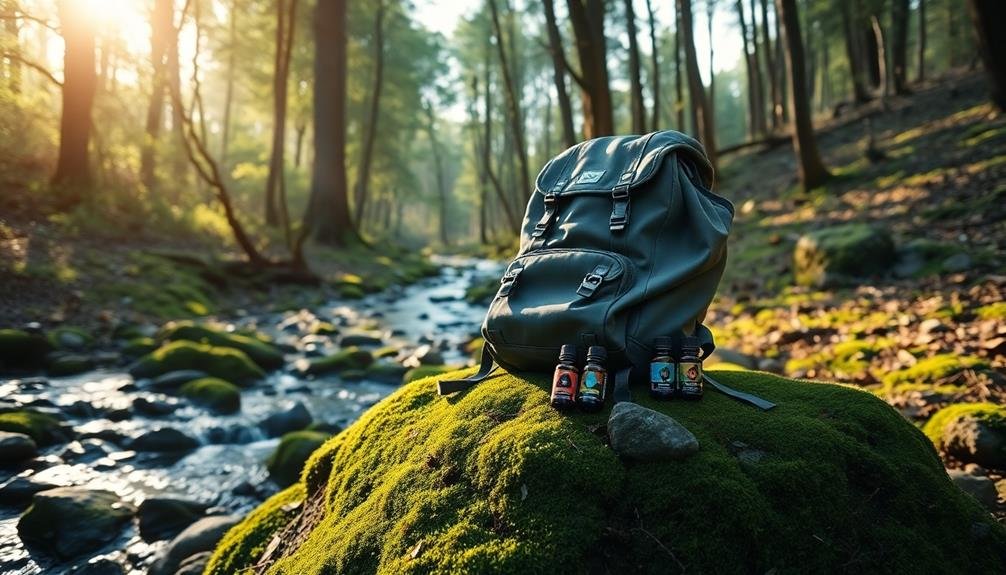
Essential oils can be a game-changer for enhancing your hiking experience and calming your nerves. When you're surrounded by nature, the right scents can ground you and help you focus. Oils like lavender are known for their relaxing properties, making them perfect for reducing anxiety while you're on the trail. Just a few drops on your wrists or a quick inhale from the bottle can create a soothing environment.
Peppermint oil is another great option. It can invigorate your senses and boost your energy, especially during a challenging ascent. A quick whiff or applying a diluted mix to your temples can keep you alert and motivated.
Additionally, consider using a blend of bergamot and chamomile to create a calming atmosphere. These oils can ease tension and promote a sense of peace, allowing you to enjoy the beauty around you without feeling overwhelmed.
Always carry a small roller bottle or a personal diffuser in your pack for easy access. With just a few moments of aromatic therapy, you'll find it easier to connect with nature and embrace the adventure ahead.
Don't underestimate the power of essential oils during your hikes!
Trail Snacks
When you're out on the trail, the right snacks can make all the difference in keeping your energy up and your spirits high.
Having nutritious and tasty snacks on hand not only fuels your body but can also uplift your mood, making your hike more enjoyable.
Here are three trail snacks you shouldn't leave home without:
- Trail Mix: A combination of nuts, dried fruits, and a sprinkle of chocolate can provide a perfect balance of healthy fats, protein, and a little sweetness to keep you energized.
- Jerky: Whether it's beef, turkey, or a plant-based option, jerky is a protein-packed snack that's easy to pack and chew, helping you stay full and focused on your adventure.
- Energy Bars: Look for bars made with whole ingredients like oats, nuts, and fruits. They're convenient and deliver a quick energy boost, perfect for those mid-hike snack breaks.
With these snacks in your pack, you'll be well-equipped to tackle the trail and keep your nerves at bay.
Enjoy the journey and munch your way to a more relaxed hiking experience!
Mapping Tools
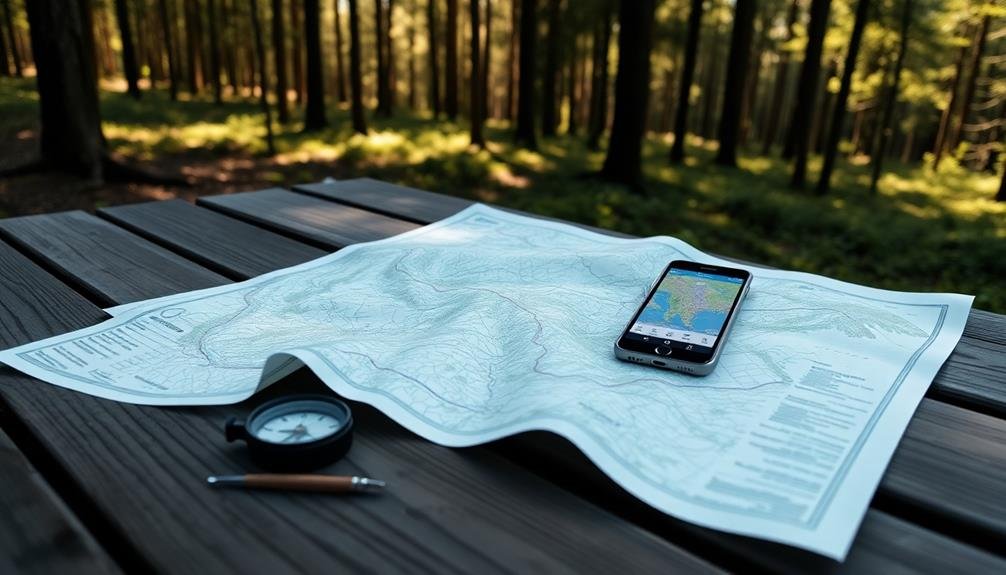
When you hit the trails, having the right mapping tools can make all the difference.
You might prefer digital navigation apps for their convenience or stick with a traditional compass for a more classic approach.
Either way, knowing how to navigate your route boosts your confidence and keeps nerves at bay.
Digital Navigation Apps
Digital navigation apps have transformed the way hikers explore new trails and landscapes. With just a smartphone in hand, you can access detailed maps, track your route, and even find points of interest nearby.
These tools not only enhance your hiking experience but also help ease nerves by providing a sense of security in unfamiliar terrain.
Here are three key benefits of using digital navigation apps:
- Real-Time GPS Tracking: You'll know your exact location on the map, making it easier to stay on course and avoid getting lost.
- Offline Maps: Many apps allow you to download maps for offline use. This means you can navigate even when cell service is spotty or non-existent.
- Trail Reviews and Tips: Access user-generated content to find out what to expect on your hike, including trail conditions, difficulty levels, and safety tips.
Traditional Compass Usage
A traditional compass can be a hiker's best friend, especially when you want to disconnect from technology and immerse yourself in nature. Using a compass not only enhances your navigation skills, but it also helps you feel more grounded and present in your surroundings.
To start, familiarize yourself with the components: the needle, baseplate, and directional markings.
When you're out on the trail, hold the compass flat in your palm, allowing the needle to settle. Align the compass housing with the direction you want to head, ensuring the needle points towards magnetic north. This simple process can boost your confidence and reduce anxiety, as you rely on instinct rather than screens.
Practice using your compass before hitting the trail; it'll help you feel more comfortable when you truly need it. Pair the compass with a good map, and you'll gain a deeper understanding of the terrain around you.
This old-school method not only calms your nerves but also enriches your hiking experience. Embrace the simplicity of a traditional compass, and you'll find yourself more connected to the wilderness, savoring every moment.
Frequently Asked Questions
How Do I Choose the Right Trail for Anxiety Relief?
When choosing a trail for anxiety relief, consider your fitness level, scenic views, and solitude. Look for well-marked paths and avoid crowded areas; nature's quiet can greatly help ease your mind and uplift your spirits.
Can Hiking Help Improve My Overall Mental Health?
Absolutely, hiking can boost your mental health. It gets you outdoors, connects you with nature, and promotes physical activity, which releases endorphins. You'll feel more relaxed, focused, and rejuvenated after each hike.
What Should I Do if I Feel Overwhelmed on a Hike?
When you feel overwhelmed on a hike, take deep breaths, find a quiet spot, and pause. Focus on your surroundings, listen to nature, and remind yourself why you love being outdoors. It'll help calm you.
Are There Specific Trails Known for Calming Nature Experiences?
Absolutely, you'll find several trails renowned for their calming experiences. Seek out serene paths through lush forests or by tranquil lakes. Nature's beauty, fresh air, and gentle sounds can help soothe your mind and spirit.
How Can I Prepare Mentally Before Going on a Hike?
Before your hike, visualize the experience you want. Focus on your breathing, set positive intentions, and remind yourself of the beauty around you. Embrace the journey; it'll help calm your nerves and enhance your enjoyment.
In Summary
When you hit the trails, the right gear can really help ease your nerves. Comfortable footwear and breathable clothing keep you relaxed, while hydration packs and lightweight backpacks make your hike enjoyable. Don't forget nature journals to capture your thoughts, sun protection gear to keep you safe, and essential oils for a calming scent. Trail snacks will fuel your adventure, and mapping tools guarantee you stay on track. Embrace the outdoors and let your worries fade away!

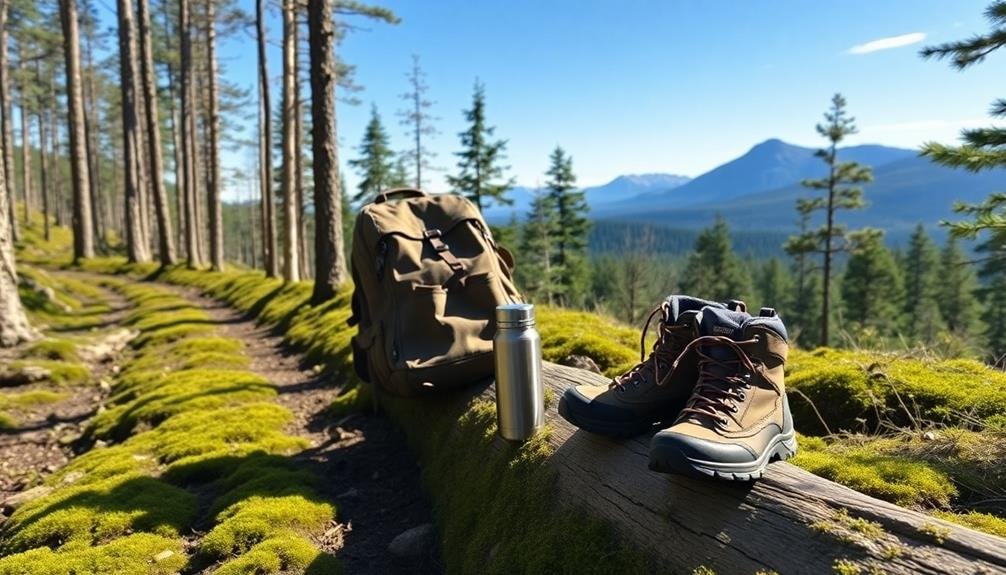



Leave a Reply